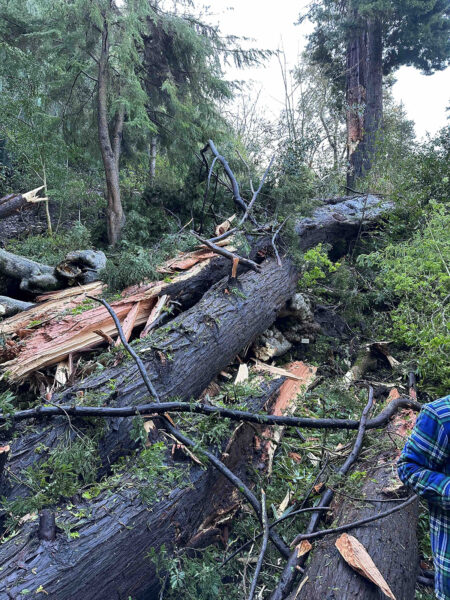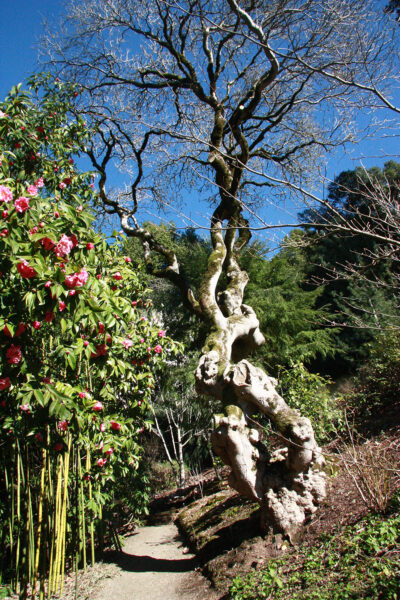
Director of Collections Andrew Doran
Dear Garden Community,
At approximately 4:30pm on Tuesday March 21st a loud crash was heard by the few remaining staff on site during the high winds that gusted through the Garden. Immediate suspicions were that the large coast redwood (Sequoia sempervirens) that predates the Garden had partially failed with the loss of one of its three leaders. The following morning, on closer inspection, this was unfortunately more catastrophic than anticipated, and decades of care and nurturing of some of Garden’s treasures had been destroyed. Not only had one entire leader sheared off the tree, but the top of one of the others had blown out, landing a considerable distance away, towards Strawberry Creek, knocking the timber bamboo askew (Phyllostachys bambusoides, 68.0963). Widespread damage to the collections occurred, including the loss of another garden icon that predates the Garden, the remarkably shaped California buckeye (Aesculus californica).

damaged coast redwood (Sequoia sempervirens) Photo: Andrew Doran
We are still assessing the damage with horticulturists, arborists, and campus tree crews as to the actions that will need to be taken. Right away we are evaluating damage to the surrounding accessions. Dozens of damaged plants will be assessed to see if they will recover with strategic pruning, if they need to be propagated, or if they are a loss. We will also be working to minimize the damage to these plants by restricting access to the area, not only to visitors, but also to tree crews that will soon need to access the area.

California buckeye (Aesculus californica) Photo: Marion Brenner
We understand it is tempting to get close to this scene, but it remains a hazardous area due to the potential for additional falling branches. Please respect the closed area notices.
In addition, damage in other collections includes the loss of one of three large spruces (Picea martinezii, 90.2472) in Mexico/Central America, the top half of the Parana pine (Araucaria angustifolia, 91.1181) in South America, one large stem of red ash (Alphitonia excelsa, 97.0403) and Eucalyptus infera (2009.0602) both from Queensland in the Australasian Area and gum-leaf cone bush (Leucadendron eucalyptifolium, 96.0063) from Southern Africa.
More information will be forthcoming as we learn of impacts to the collections.
The good news is that the Southern Africa Area is on the cusp of a spectacular super bloom; the newts are breeding; and Garden staff are well.
Andrew Doran
Director of Collections
Support the Garden:
Give Now
